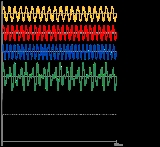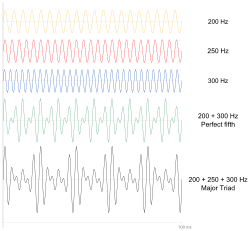
Major chord
Encyclopedia

Music theory
Music theory is the study of how music works. It examines the language and notation of music. It seeks to identify patterns and structures in composers' techniques across or within genres, styles, or historical periods...
, a major chord is a chord
Chord (music)
A chord in music is any harmonic set of two–three or more notes that is heard as if sounding simultaneously. These need not actually be played together: arpeggios and broken chords may for many practical and theoretical purposes be understood as chords...
having a root
Root (chord)
In music theory, the root of a chord is the note or pitch upon which a triadic chord is built. For example, the root of the major triad C-E-G is C....
, a major third
Major third
In classical music from Western culture, a third is a musical interval encompassing three staff positions , and the major third is one of two commonly occurring thirds. It is qualified as major because it is the largest of the two: the major third spans four semitones, the minor third three...
, and a perfect fifth
Perfect fifth
In classical music from Western culture, a fifth is a musical interval encompassing five staff positions , and the perfect fifth is a fifth spanning seven semitones, or in meantone, four diatonic semitones and three chromatic semitones...
. When a chord has these three notes alone, it is called a major triad
Triad (music)
In music and music theory, a triad is a three-note chord that can be stacked in thirds. Its members, when actually stacked in thirds, from lowest pitched tone to highest, are called:* the Root...
. Some major triads with additional notes, such as the major seventh chord
Major seventh chord
In music, a major seventh chord is any nondominant seventh chord where the "third" note is a major third above the root.Most typically, major seventh chord refers to where the "seventh" note is a major seventh above the root . This is more precisely known as the major/major seventh chord, and it...
, may also be called major chords.
A major triad can also be described as a major third interval
Interval (music)
In music theory, an interval is a combination of two notes, or the ratio between their frequencies. Two-note combinations are also called dyads...
with a minor third
Minor third
In classical music from Western culture, a third is a musical interval encompassing three staff positions , and the minor third is one of two commonly occurring thirds. The minor quality specification identifies it as being the smallest of the two: the minor third spans three semitones, the major...
interval on top or as a root note, a note 4 semitone
Semitone
A semitone, also called a half step or a half tone, is the smallest musical interval commonly used in Western tonal music, and it is considered the most dissonant when sounded harmonically....
s higher than the root, and a note 7 semitones higher than the root.
A minor chord
Minor chord
In music theory, a minor chord is a chord having a root, a minor third, and a perfect fifth.When a chord has these three notes alone, it is called a minor triad....
differs from a major chord in having a minor third above the root instead of a major third.
It can also be described as a minor third with a major third on top, in contrast to a major chord, which has a major third with a minor third on top. They both contain fifths, because a major third (4 semitones) plus a minor third (3 semitones) equals a fifth (7 semitones).
An augmented chord is like a major chord, but with a raised fifth.
An example of a major chord is the C major chord, which consists of the notes C, E and G.

Just intonation
In music, just intonation is any musical tuning in which the frequencies of notes are related by ratios of small whole numbers. Any interval tuned in this way is called a just interval. The two notes in any just interval are members of the same harmonic series...
a major chord is tuned to the frequency ratio 4:5:6 . This may be found on I, IV, V, VI, III, and VI. In equal temperament
Equal temperament
An equal temperament is a musical temperament, or a system of tuning, in which every pair of adjacent notes has an identical frequency ratio. As pitch is perceived roughly as the logarithm of frequency, this means that the perceived "distance" from every note to its nearest neighbor is the same for...
it has 4 semitone
Semitone
A semitone, also called a half step or a half tone, is the smallest musical interval commonly used in Western tonal music, and it is considered the most dissonant when sounded harmonically....
s between the root and third, 3 between the third and fifth, and 7 between the root and fifth. It is represented by the integer notation (0, 4, 7}. In equal temperament, the fifth is only two cents
Cent (music)
The cent is a logarithmic unit of measure used for musical intervals. Twelve-tone equal temperament divides the octave into 12 semitones of 100 cents each...
narrower than the just perfect fifth, but the major third is noticeably different at about 14 cents wider.
The major chord, along with the minor chord, is one of the basic building blocks of tonal
Tonality
Tonality is a system of music in which specific hierarchical pitch relationships are based on a key "center", or tonic. The term tonalité originated with Alexandre-Étienne Choron and was borrowed by François-Joseph Fétis in 1840...
music and the common practice period
Common practice period
The common practice period, in the history of Western art music , spanning the Baroque, Classical, and Romantic periods, lasted from c. 1600 to c. 1900.-General characteristics:...
. It is considered consonant
Consonance and dissonance
In music, a consonance is a harmony, chord, or interval considered stable, as opposed to a dissonance , which is considered to be unstable...
, stable, or not requiring resolution
Resolution (music)
Resolution in western tonal music theory is the move of a note or chord from dissonance to a consonance .Dissonance, resolution, and suspense can be used to create musical interest...
. In Western music, a minor chord, in comparison, "sounds darker than a major chord."
Major chord table
| Chord | Root | Major Third | Perfect Fifth |
|---|---|---|---|
| C | C | E | G |
| C | E (F) | G | |
| D | F | A | |
| D | D | F | A |
| D | F (G) | A | |
| E | G | B | |
| E | E | G | B |
| F | F | A | C |
| F | A | C | |
| G | B | D | |
| G | G | B | D |
| G | B (C) | D | |
| A | C | E | |
| A | A | C | E |
| A | C (D) | E (F) | |
| B | D | F | |
| B | B | D | F |
See also
- Major and minorMajor and minorIn Western music, the adjectives major and minor can describe a musical composition, movement, section, scale, key, chord, or interval.Major and minor are frequently referred to in the titles of classical compositions, especially in reference to the key of a piece.-Intervals and chords:With regard...
- Musical tuningMusical tuningIn music, there are two common meanings for tuning:* Tuning practice, the act of tuning an instrument or voice.* Tuning systems, the various systems of pitches used to tune an instrument, and their theoretical bases.-Tuning practice:...
- Minor chordMinor chordIn music theory, a minor chord is a chord having a root, a minor third, and a perfect fifth.When a chord has these three notes alone, it is called a minor triad....
- Otonality and UtonalityOtonality and UtonalityOtonality and Utonality are terms introduced by Harry Partch to describe chords whose notes are the overtones or "undertones" of a given fixed tone. For example: 1/1, 2/1, 3/1,.....

